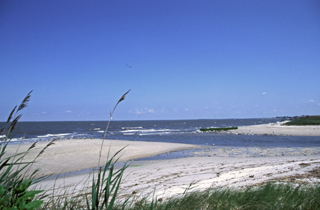|
Trail Guides
|
Cape May NWR - Kimbles Beach
|
6
 
|
24 Kimbles Beach Rd, Cape May Court House, NJ 08210
Phone: (609) 463-0994
www.fws.gov/northeast/capemay
U.S. Fish and Wildlife Service
Drive back down Reed’s Beach
Rd. and turn Right onto Route 47 South. After
0.6 miles, turn Right onto Kimbles Beach Rd.,
just south of Hand Ave. The road sign is easy to miss (it is a thin white post with the street name written on it vertically). There is private property along the first 1⁄4 mile of road, and then the
refuge begins. The refuge headquarters is less than half a mile from Route 47. The road passes private and refuge land for a mile then dead
ends at the Delaware Bay. Map
 |
| Kimbles and Cooks Beaches | Kevin Karlson |
| |
| | Kimbles Beach has an interesting mix of upland fields, mature forest, tidal wetlands, and beach habitats all in proximity to one another. On the right side of the road, there is a universally accessible trail that goes through a mix of habitats for just over a half mile. It is wide and level and has a fine crushed gravel
surface. Enjoy panoramic views out over the Delaware Bay when you reach the end of Kimbles Beach Rd. In spring, the beach is often busy
with migrating shorebirds feeding on horseshoe crab eggs.
This is a great time for birding along the fields and trails for wintering sparrows. Look for ducks and loons off in the Delaware Bay and Eastern Bluebird along the road.
Migrating songbirds including warblers and sparrows can be found in the woodlands and
overgrown fields. At dawn and dusk American Woodcock can be heard performing their flight display from weedy fields.
Many songbirds stay to nest including Prairie Warbler, Field Sparrow, Eastern Bluebird, Ovenbird, Great Crested Flycatcher, Blue Grosbeak, Indigo Bunting, among others. This is also a good time to look for butterflies and
dragonflies in the habitats along the road.
Southbound migrants take advantage of the mix of habitats to refuel for their long journeys. These include both songbirds and raptors of many species.
|
|
|